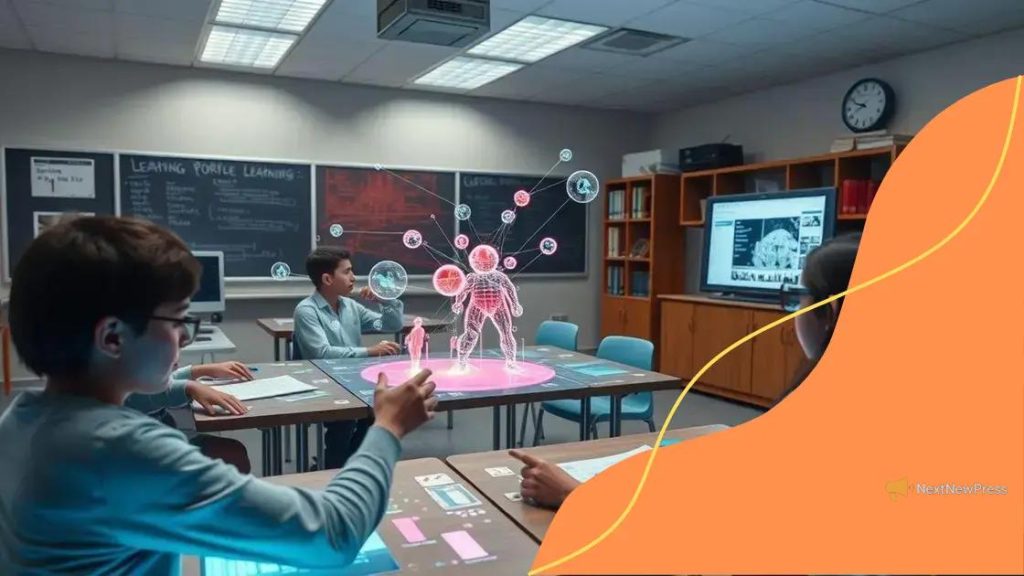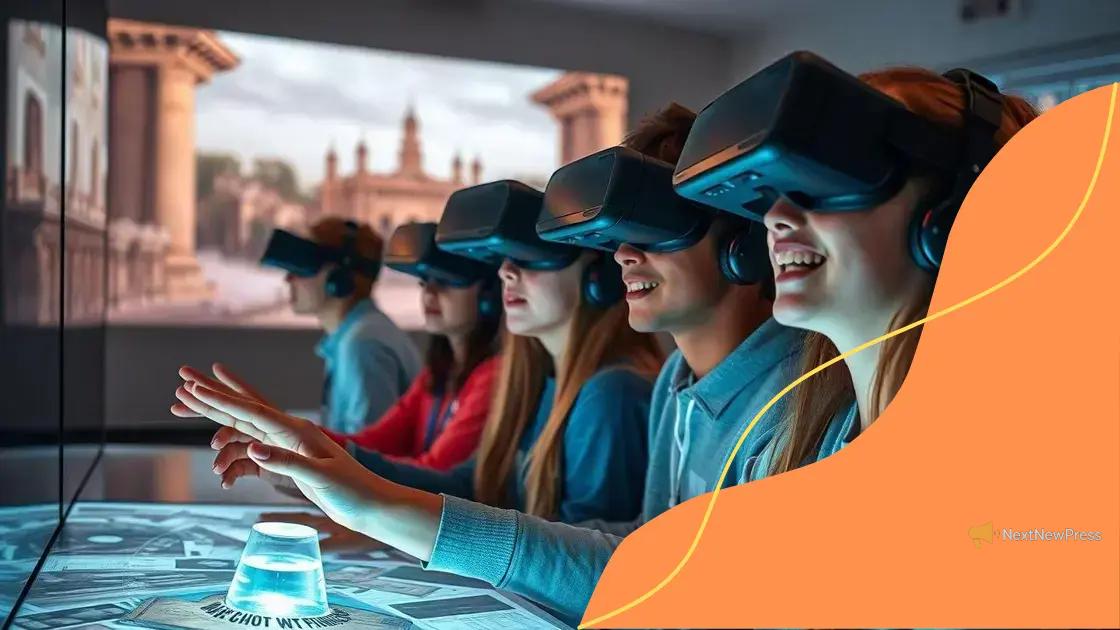Augmented reality for immersive learning experiences

Augmented reality for immersive learning enhances student engagement, retention, and personalized experiences, while presenting challenges such as technical limitations and content development in educational settings.
Augmented reality for immersive learning is changing the way we educate and train. Imagine stepping into a learning environment where concepts come to life right before your eyes. This technology opens up a world of possibilities, inviting us to explore various facets of education like never before.
Understanding augmented reality
Understanding augmented reality is essential in today’s digital age. This technology blends the real world with digital elements, making learning more engaging. With AR, students can visualize complex concepts and interact with content in innovative ways.
What is Augmented Reality?
Augmented reality (AR) enhances the real world by overlaying digital information. This can include images, videos, and sounds that are seamlessly integrated into our surroundings. For example, with a smartphone or AR glasses, learners can see 3D models of anatomy while studying biology.
This technology is significant because it makes abstract ideas more concrete. Augmented reality creates immersive experiences that can boost memory retention and understanding.
Key Features of Augmented Reality
- Real-time interaction
- Integration of digital content into the environment
- 3D visualization capabilities
- User-friendly interfaces
In educational settings, AR provides opportunities for experiential learning. Instead of just reading about historical events, students can visit virtual recreations of them. This interaction helps to create lasting memories.
As learners engage with AR, they develop skills such as critical thinking and problem-solving. They can explore scenarios and make choices that enhance their understanding of the subject matter. This active participation makes the learning process more enjoyable, fostering a love for knowledge.
Applications in Various Fields
AR is not limited to education; it also finds applications in fields like healthcare, engineering, and entertainment. Surgeons can use AR to visualize patient anatomy before performing procedures, improving accuracy and outcomes.
Moreover, engineers can see how their designs fit into the real world through AR simulations. This technology allows for adjustments and improvements before physical prototypes are created, saving time and resources.
Applications of augmented reality in education
The applications of augmented reality in education are vast and exciting. This technology offers unique ways to enhance learning experiences. Students can engage with lessons in a way that traditional methods can’t match.
Interactive Learning Experiences
One of the primary benefits of using AR in education is creating interactive learning experiences. When students can see and interact with digital content, they become more engaged. For instance, in a science class, a student might explore the solar system by viewing 3D models of planets through a device.
- Enhanced visualization of complex topics
- Real-time feedback and interaction
- Improved student motivation
- Collaborative learning opportunities
These elements make lessons more memorable. Students not only retain information better but also find learning more enjoyable.
Field Trips and Virtual Experiences
Augmented reality can also replace traditional field trips. Imagine taking a trip to ancient Rome without leaving the classroom. AR allows students to explore historical sites and landmarks through their devices. They can experience these environments as if they were actually there.
This immersive technology also supports diverse learning styles. Visual learners benefit from seeing content, while hands-on learners engage through interaction. By accommodating different preferences, AR promotes inclusivity in the classroom.
Support for Teachers
Teachers can utilize augmented reality to enhance their instruction. AR tools help them create dynamic lessons that address various educational standards. These resources are ideal for demonstrating complex concepts, making abstract material easier to understand. Moreover, AR can simplify classroom management by keeping students focused and involved.
As AR continues to evolve, its integration into educational systems will likely expand. This ensures that learning remains relevant in our technology-driven world. With the right tools, teachers can prepare students for future challenges and opportunities.
Benefits of immersive learning

The benefits of immersive learning are significant, making education more impactful and engaging. This approach takes learning beyond textbooks and lectures, allowing students to experience content in a hands-on manner.
Enhanced Engagement
Immersive learning captures students’ attention. When they can interact with the material, they are more likely to stay focused. For instance, using virtual reality or augmented reality tools, students can explore different environments. This makes lessons come alive and helps them remember what they’ve learned.
- Active participation in their learning process
- Greater motivation to explore new topics
- Increased enthusiasm for schooling
- Stronger connections to the subject matter
As a result, students develop a deeper understanding of concepts through active involvement. They can apply what they’ve learned in real-world situations.
Improved Retention
Another key benefit is improved information retention. When students engage directly with content, they often remember more. Learning through experiences creates lasting memories. Whether it’s through simulations or collaborative projects, immersive learning promotes long-term understanding.
These lessons often resonate on an emotional level, leading to better recall. The brain tends to remember experiences associated with emotions, making immersive learning effective.
Development of Critical Skills
Immersive learning not only enhances engagement and retention but also fosters essential skills. Students gain critical thinking and problem-solving abilities as they navigate complex scenarios. They learn to analyze situations and make decisions in real time.
Furthermore, working in teams during immersive activities encourages collaboration and communication skills. Students learn to express their ideas clearly and work together effectively towards common goals. These skills are invaluable in the modern workforce.
Challenges in implementing augmented reality
The challenges in implementing augmented reality in education can be significant, despite its many benefits. Understanding these challenges helps educators prepare for the future of teaching.
Technical Limitations
One major challenge is the technical limitations of augmented reality tools. Many schools lack the necessary hardware, such as AR headsets or smartphones. Additionally, software compatibility issues can arise, making it difficult to integrate AR applications into existing curricula. Not all teachers may feel confident using these technologies, which can hinder successful implementation.
- High costs of AR devices and software
- Inconsistent access to technology
- Need for ongoing technical support
- Training requirements for staff
As a result, some educators may hesitate to fully embrace AR, fearing that it will complicate their lessons more than enhance them.
Content Development
Another challenge lies in content development. While AR offers exciting opportunities, creating engaging and relevant content can be time-consuming. Teachers often need to develop custom materials, which can be overwhelming.
This process requires not only creativity but also a deep understanding of the technology. Teachers may not have the time or resources to produce high-quality AR experiences, which can limit their use of the technology.
Student Readiness
Student readiness is also a concern. Not all students may be comfortable using AR technologies. Some may struggle with the new interfaces or find it challenging to adjust to interactive learning environments. It is essential for educators to identify and address these readiness levels before implementing AR. Educators can offer support and training sessions to help students feel more confident.
Finally, educators must also consider the potential distractions that AR may present. While engaging, some students might lose focus on the core learning objectives during AR activities. Balancing engagement with educational goals is critical for successful implementation.
Future trends in augmented reality for education
The future trends in augmented reality for education are promising and exciting. As technology evolves, AR will likely shape how students learn and interact with content. Educators and students alike can look forward to a more engaging educational experience.
Increased Accessibility
One major trend is the increased accessibility of augmented reality tools. As technology becomes more affordable, more schools will be able to incorporate AR into their classrooms. This means that even students in underfunded areas can benefit from immersive learning experiences. Apps and devices will continue to improve, requiring less technical expertise to use effectively.
- Growth in affordable AR devices
- More user-friendly applications
- Integration with existing educational platforms
- Wider access to high-speed internet
As these tools become more commonplace, educators will find innovative ways to enhance their teaching methods.
Personalized Learning Experiences
Another important trend is the move towards personalized learning. With augmented reality, teachers can tailor lessons to suit individual students. This customization allows learners to progress at their own pace, exploring subjects they are passionate about. AR can provide feedback in real time, helping students understand their strengths and areas for improvement.
As a result, students will have the opportunity to dive deeper into topics of interest and develop a more profound love for learning. By using data analytics, educators can create more effective learning environments.
Collaboration and Social Learning
Future AR technologies are also expected to foster collaboration among students. As AR becomes more integrated into classroom activities, peer interactions will enhance such experiences. Students can work together on projects, share insights, and explore content collectively.
This collaboration is crucial for building teamwork skills essential for the future workforce. Tools that support group projects with AR features will become more common, enriching the learning experience.
FAQ – Frequently Asked Questions about Augmented Reality in Education
How does augmented reality enhance student engagement?
Augmented reality makes learning interactive, capturing students’ attention and allowing them to explore content in a hands-on way.
What are the main challenges in implementing augmented reality in classrooms?
Challenges include technical limitations, the need for training, and the creation of quality content, which can make implementation difficult.
Can augmented reality support personalized learning?
Yes, AR technology allows teachers to customize lessons to meet each student’s needs and learning pace.
What future trends should we expect in augmented reality for education?
Future trends include greater accessibility of AR tools, more personalized learning experiences, and enhanced collaboration among students.





